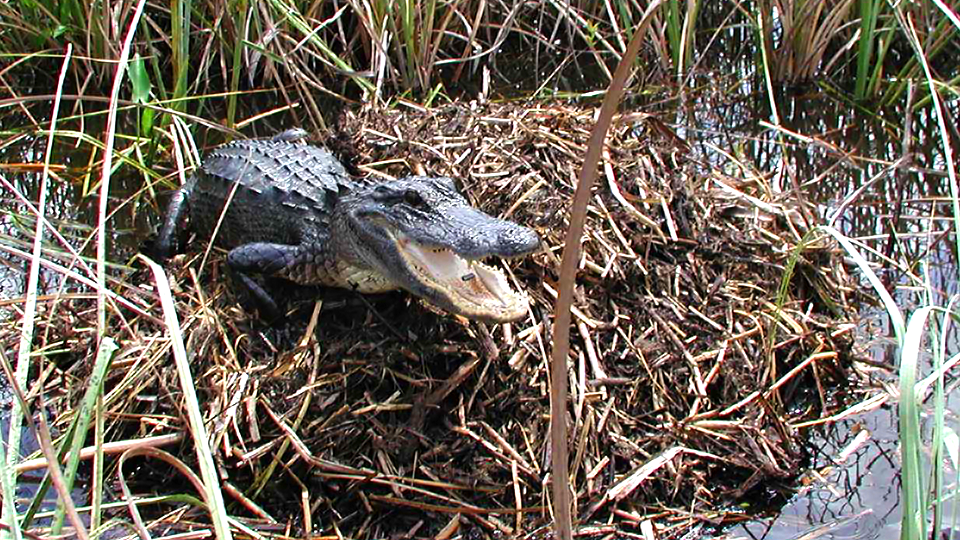
At-home activity: Build an alligator nest
Alligators, which are members of the order Crocodylia, make nests out of plants and decomposing vegetation in their habitat. The nest protects and camouflages the clutch of eggs from predators, and the temperature inside the nest influences the sex of the alligator’s offspring. Nest temperatures within the range of 86–93 degrees will have both male and female offspring. If the temperature goes above 93 degrees, however, the eggs will develop as male, and if the temperature dips below 86 degrees the offspring will develop as female.
What influences the temperature of the nest? Let's build a model to find out! Below are instructions for making an outdoor or an indoor version of this activity.
Outdoor model
Materials:
3 hard boiled eggs still in the hot water
Thumb tack, thin nail, or a large sewing needle
A grocery bag of vegetation like grass clippings, leaves, straw, or garden debris
A grocery bag of compost, dirt, or mud
Timer
Thermometer
Directions:
Boil the eggs: Place eggs in a saucepan with cold water so that the eggs are in a single layer and covered by at least an inch or two of water. Bring the water to a full rolling boil, then turn off the heat, keep the pan on the burner and let sit for 10-12 minutes.
When the eggs have finished boiling, cool the eggs in cold water for about 15 minutes.
Measure the internal temperature of each egg by poking a hole through the shell with a thumb tack, thin nail, or a large sewing needle, then insert the thermometer through the hole you created.
Write down the temperature of each egg, then calculate the average temperature and record it. Now you have a base temperature to compare with the temperature after being in the nest.
Find a secluded, sunny, and dry place outside where the nest will blend in with its surroundings. This location will help to camouflage your nest, just like alligators do in the wild.
Place the eggs on the spot, then cover them with layers of vegetation and compost. You want the mound to be a cone shape with more materials on top to make an insulating roof. Gently pat the mound to compact the materials around the eggs.
Set the timer for 30 minutes
When your timer is done, bring your thermometer to the nest and insert the thermometer into the nest until you can feel the eggs. What is the temperature in the nest?
Next, measure the internal temperature of each egg and write it down. Did the temperatures change? If it is five or more degrees above the base temperature, your imaginary baby gators would be male. If the temperature is five or more degrees below the base temperature, your imaginary baby gators would be female.
Clean up your experiment by putting all the nest materials in your compost bin or take it all to a local compost site.
Indoor model
Materials:
3 hard boiled eggs still in the hot water
Blanket or laundry basket of clean warm clothes
Timer
Thermometer
Directions:
Boil the eggs as described in step 1 above.
When the eggs have finished boiling, cool the eggs in cold water for about 15 minutes.
Measure the internal temperature of each egg by poking a hole through the shell with a thumb tack, thin nail, or a large sewing needle, then insert the thermometer through the hole you created.
Write down the temperature of each egg, then calculate the average temperature and record it. Now you have a base temperature to compare with the temperature after being in the nest.
Find a location in your house where the blanket or pile of clothes will not look out of place. This location will help to camouflage your nest, just like alligators do in the wild.
Put the eggs in place and cover them with a mound of blanket or a pile of clothes. Pat the mound around the eggs to make sure there are no holes leading to the eggs.
Set the timer for 30 minutes
When your timer is done, bring your thermometer to the nest. Removing as little of the nest as you can, insert the thermometer into the nest until you can feel the eggs. What is the temperature in the nest?
Next, measure the internal temperature of each egg and write it down. Did the temperatures change? If it is five or more degrees above the base temperature, your imaginary baby gators would be male. If the temperature is five or more degrees below the base temperature, your imaginary baby gators would be female.
Clean up by putting the blanket back where you found it and the clothes back in the hamper. You can eat the eggs or put them in the fridge for a snack for later if you’ve had them in the nest for less than an hour.
Questions to consider:
How could you change the mound to make it warmer or cooler?
What could be affecting the temperature besides the nest?
Alligator eggs take about two and a half months to incubate. The attentive mother alligator guards the nest that whole time! When the babies start hatching they call out to their mother; the hatchling’s throaty cry sounds like a laser in a video game. You can see and hear an alligator hatching here, and let us know how your experiment went on social media using the hashtag #ShareYourDiscovery!